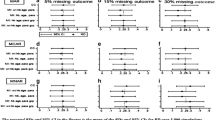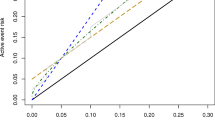Abstract
Matched-pair design is often adopted in equivalence or non-inferiority trials to increase the efficiency of binary-outcome treatment comparison. Briefly, subjects are required to participate in two binary-outcome treatments (e.g., old and new treatments via crossover design) under study. To establish the equivalence between the two treatments at the α significance level, a (1−α)100% confidence interval for the correlated proportion difference is constructed and determined if it is entirely lying in the interval (−δ 0,δ 0) for some clinically acceptable threshold δ 0 (e.g., 0.05). Nonetheless, some subjects may not be able to go through both treatments in practice and incomplete data thus arise. In this article, a hybrid method for confidence interval construction for correlated rate difference is proposed to establish equivalence between two treatments in matched-pair studies in the presence of incomplete data. The basic idea is to recover variance estimates from readily available confidence limits for single parameters. We compare the hybrid Agresti–Coull, Wilson score and Jeffreys confidence intervals with the asymptotic Wald and score confidence intervals with respect to their empirical coverage probabilities, expected confidence widths, ratios of left non-coverage probability, and total non-coverage probability. Our simulation studies suggest that the Agresti–Coull hybrid confidence intervals is better than the score-test-based and likelihood-ratio-based confidence interval in small to moderate sample sizes in the sense that the hybrid confidence interval controls its true coverage probabilities around the pre-assigned coverage level well and yield shorter expected confidence widths. A real medical equivalence trial with incomplete data is used to illustrate the proposed methodologies.
Similar content being viewed by others
References
Agresti A, Coull B (1998) Approximate is better than ‘exact’ for interval estimation of binomial proportion. Am Stat 52:119–126
Bartlett MS (1953) Approximate confidence interval more than one unknown parameters. Biometrika 40:306–317
Bhoj DS, Snijders TAB (1986) Testing equality of correlated proportions with incomplete data on both response. Psychometrika 4:579–588
Brown LD, Cai T, Dasgupta A (2001) Interval estimation for a binomial proportion (with discussion). Stat Sci 16:101–133
Chan ISF (2004) Noninferiority and equivalence trials. J Biopharm Stat 14:261–262
Choi SC, Stablein DM (1982) Practical tests for comparing two proportions with incomplete data. Appl Stat 31:256–262
Food and Drug Administration (2010). Draft guidance for industry on noninferiority trials. http://www.fda.gov/downloads/Drugs/GuidanceComplianceRegulatoryInformation/Guidances/UCM201240.pdf
Lui KJ (1998) Comment on confidence intervals for differences in correlated binary proportions. Stat Med 17:2017–2020
May WL, Johnson WD (1997) Confidence intervals for differences in correlated binary proportions. Stat Med 16:2127–2136
Newcombe RG (1998a) Interval estimation for the difference between independent proportions: comparison of eleven methods. Stat Med 17:873–890
Newcombe RG (1998b) Improved confidence intervals for the difference between binomial proportions based on paired data. Stat Med 17:2635–2650
Newcombe RG (2003) Confidence intervals for the mean of a variable taking the values 0, 1 and 2. Stat Med 22:2737–2750
Osoba D, Erlichman C, Willan AR, Levitt M, Pater JL (1986) Superiority of methylprednisolone sodium succinate over low dose metoclopramide hydrochloride in the prevention of nausea and vomiting produced by cancer chemotherapy. Clin Invest Med 9:225–231
Quesenberry CP, Hurst DC (1964) Large sample simultaneous confidence intervals for multinomial proportions. Technometrics 6:191–195
Tang ML, Tang NS (2004) Exact tests for comparing two paired proportions with incomplete data. Biom J 46:72–82
Tang ML, Tang NS, Chan ISF (2005) Confidence interval construction for proportion difference in small-sample paired studies. Stat Med 24:3565–3579
Tang ML, Ling MH, Tian GL (2009) Exact and approximate unconditional confidence intervals for proportion difference in the presence of incomplete data. Stat Med 28:625–641
Tang T (2000) Confidence intervals for differences in correlated binary proportions. Stat Med 19:133–139
Tango T (1998) Equivalence test and confidence interval for the difference in proportions for the paired-sample design. Stat Med 17:891–908
Zou GY, Donner A (2008) Construction of confidence limits about effect measures: A general approach. Stat Med 27:1693–1702
Author information
Authors and Affiliations
Corresponding author
Rights and permissions
About this article
Cite this article
Tang, ML., Li, HQ., Chan, I.S.F. et al. On Confidence Interval Construction for Establishing Equivalence of Two Binary-Outcome Treatments in Matched-Pair Studies in the Presence of Incomplete Data. Stat Biosci 3, 223–249 (2011). https://doi.org/10.1007/s12561-011-9044-3
Received:
Accepted:
Published:
Issue Date:
DOI: https://doi.org/10.1007/s12561-011-9044-3




